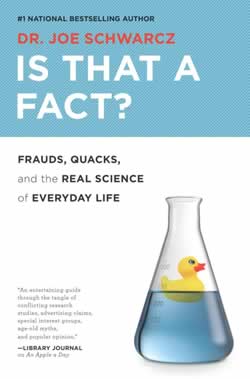One of the first reviews of "Is That a Fact?"
Posted by¬Ý¬Ýon April 29, 2014 (Ã˝∞‰¥«≥æ≥æ±≤‘≥Ÿ≤ı)
Not long ago¬Ý. Joe Schwarcz (‚ÄúDr. Joe‚Äù) was one of the three professors teaching that course. He also has a radio show, a blog, a podcast, and he writes books. His newest book will be of particular interest to SBM readers:¬Ý.

I reviewed an earlier book of his,Ã˝The Right Chemistry, for¬ÝSkeptic¬Ýmagazine. You can read my review online¬Ý. I called him ‚ÄúThe Carl Sagan of Chemistry‚Äù for his ability to popularize science and make it not only palatable but fascinating and entertaining. In the new book, Dr. Joe turns his attention to exactly the kind of subjects we cover on this blog. He is a chemist and most of us are physicians, but we reach the same conclusions because we look at the evidence from the same rigorous scientific viewpoint.
±ı≤‘Ã˝The Right Chemistry, Dr. Joe explains that ‚Äúchemical‚Äù does not mean ‚Äúbad stuff‚Äù ‚Äî chemicals make up the entire world, and we are made of chemicals that our own body manufactures. He shares his encyclopedic store of obscure and intriguing scientific facts. Have you ever heard of kangatarians? Did you know asparagus can grow up to 10 inches a day? Can you explain why crystals of Epsom salts crumble if you yell at them? Do you think explosives can‚Äôt be made on a plane with small amounts of liquids? (Dr. Joe thinks they can, but for obvious reasons he‚Äôs not divulging the recipe.) You probably didn‚Äôt know that in World War II the U.S. military developed a mixture called ‚ÄúWho Me?‚Äù that smelled like feces and was dispensed with an atomizer. French Resistance fighters were supposed to surreptitiously spray it on German officers to embarrass them, but it wasn‚Äôt a great success since the sprayer ended up as stinky as the sprayee.
Is That a Fact?¬Ýstarts by asking how we know what we know. Scientific knowledge depends on ever-accumulating evidence, and we have different degrees of certainty about different topics. Schwarcz conveniently divides his book into black, gray and white sections: white entries are factual, grays are a blend of fact and falsehood, and black are ‚Äúpretty dismal‚Äù when it comes to facts.
Black
Starting with an overview of quackery, he goes on to recount his personal encounter with an intuitive healer who told him she could “see” that his body was infested with worms, bacteria, mushrooms and viruses. He goes on to discuss bogus cancer cures, colon cleansing, pokeweed, vinegar, how to diagnose pathological science, double helix water, homeopathy, fakery, Braco the Gazer (who makes millions just standing on stage and gazing at the audience), celebrity endorsements, rhino horn, HCG diets, and other topics. Each is presented in a short segment of 4 or 5 pages.
Gray
In this section he covers claims that go beyond the evidence and he critiques the studies the claims are based on. Topics include fish oil supplements, blueberries and other fruit claims, leeches, toxic chemicals, healthy diets, weight loss, tropical oils, antioxidants, the supplement industry, pesticides, deer antlers, Dr. Oz, breatharians and nutritarians, pink slime, colloidal silver, salt therapy, water scams, buckeyballs, and foods made from genetically modified organisms (GMO).
White
Here he covers the chemical bogeymen BPA and PVC and why he’s not worried about them, static electricity, laboratory accidents, formaldehyde to prevent clothes from wrinkling, meat production, dry ice, mirrors, hormones that make you cuddle, neoprene, the Olympic torch, non-browning apples, orange juice, opiates, nitrous oxide, antibiotics, gluten, geysers, kiwis (both the bird and the fruit), duels by Calabar bean, superfruits, mesmerism, energy medicine, and the power of belief.
Resomation [not a typo]
In a short final chapter, he explains how resomation works: dissolving the body into its chemical components by acid hydrolysis. He compares it to other ways of disposing of our body’s chemical ingredients after death.
Conclusion
This book is not only informative but is a delight to read. Throughout, Dr. Joe interweaves chemistry with medicine, critical thinking, and the scientific method. His explanations are simple and lucid. He has a way with words, and the book is filled with funny comments like “Dr. Oz puts his facts on a diet when it comes to fattening up his television ratings.”
±ı≥Ÿ‚ÄôsÃ˝. If you don‚Äôt want to spend your hard-earned money, you could ask your local library to purchase it, or you can get a free sample of Dr. Joe‚Äôs wit and wisdom at these websites:
- ∞’≥Û±Ã˝Office for Science and SocietyÃ˝(,Ã˝,Ã˝,Ã˝,Ã˝)
Read More:¬Ý
